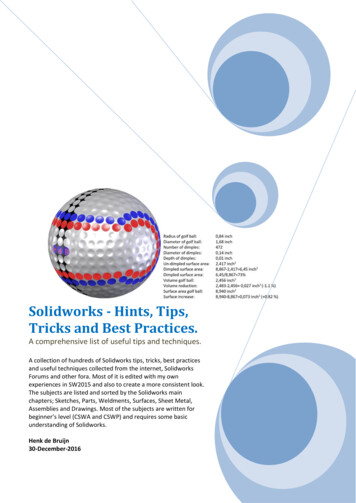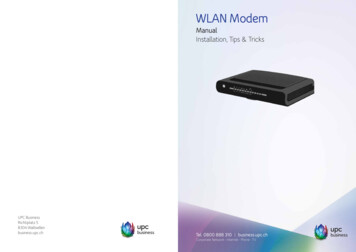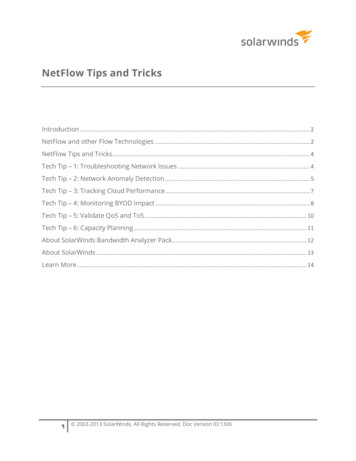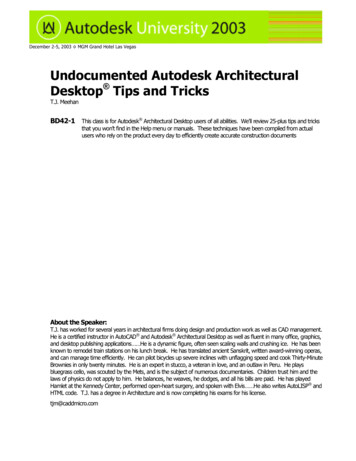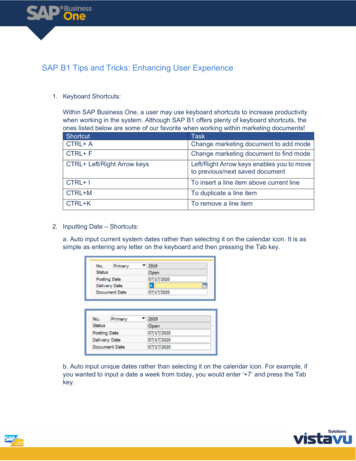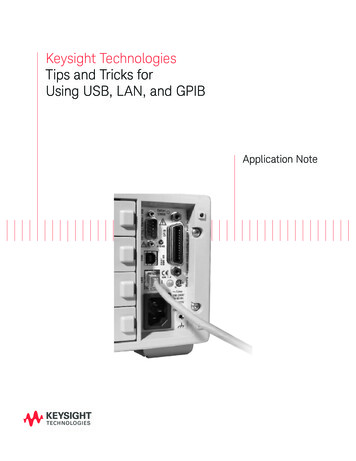
Transcription
Keysight TechnologiesTips and Tricks forUsing USB, LAN, and GPIBApplication Note
IntroductionGPIB has been and will continue to be a popular choice for input/output (I/O) intest equipment. However, with high performance LAN and USB ports built intomost current generation PCs, many test-system developers are ready to explorethe benefits of using LAN or USB for instrument I/O.Keysight Technologies, Inc. was one of the first test-and-measurement (T&M)manufacturers to enable those benefits by including LAN and USB ports in itsinstruments and by offering I/O drivers, software, and configuration tools thatmake connections as easy as using GPIB. Along the way, Keysight has beenworking with other manufacturers to develop T&M-specific standards thatenhance LAN and USB for use in test systems.This application note provides a variety of tips and tricks that will help you createflexible test systems that can easily incorporate USB, LAN, GPIB, and RS-232C.By expanding your range of I/O alternatives you can enable new usage modelsthat boost productivity, and add new tools that protect your investments insystem hardware and software. The foundation of these benefits is an approachwe call Keysight Open, which simplifies system development through systemready instrumentation, open software environments, and PC-standard I/O.Tip:Utilize faster, simpler I/Othat’s built inMost current-generation PCs include one high-speed LAN port and multipleUSB ports. An increasing number of measurement instruments-and most newKeysight instruments-now include LAN and USB ports alongside the GPIBconnector. It’s likely that all three interfaces will coexist for years to come.Compared to GPIB, the PC-standard interfaces offer similar or superiorperformance with greater convenience and lower cost.1 Because the interfacesare built into today’s PCs, there is no need to open the computer and install aGPIB card. What’s more, high quality LAN and USB cables are typically lessexpensive than a GPIB cable of equal length. With these advantages, LAN andUSB will often be a better choice than GPIB (or extensions such as HS-488)when creating a new test system.If you’re concerned about instrument programming, two recently developedT&M standards ensure that it’s virtually identical whether you use GPIB, LANor USB. The VXI-11 protocol defines LAN-based communication for all types oftest equipment, not just VXI, and the USBTMC-USB488 standard extends USBfor T&M applications.VXI-11 and USBTMC both create an I/O connection that looks just like GPIB toa PC-based application. This means existing GPIB programs-and everythingyou’ve learned over the years about GPIB programming-can be used virtuallyunchanged if you choose to connect via LAN or USB. This is especially true ifyou also use the VISA I/O API.2 With USB, the only additional step is setting theinstrument address to meet the USB naming convention.Keysight initiated the creation of both VXI-11 and USBTMC and is committedto driving the T&M industry toward wider use of PC-standard I/O. We will alsocontinue to work with other instrument vendors to define and develop openstandards that will deliver technical and economic advantages to systemdevelopers.1.To ensure top performance, isolate the LAN or USB connection from any non-instrumentation data traffic.2. Virtual Instrument Software Architecture input/output application programming interface.To learn more, please see the glossary on page 11.2
Trick:Connect to GPIB instrumentsvia USB (or LAN)Envision a brand new desktop or notebook PC sitting on your desk. Now imaginethat you’d like to connect it to the oscilloscope on your workbench and thenstep through some saved configurations, make a few quick measurements,transfer the data, and analyze the results. There’s one small problem: the PChas LAN and USB interfaces but the scope has a GPIB port. Fortunately, ahandy converter unit makes it easy to connect GPIB instruments to your newPC.The Keysight 82357B USB/GPIB interface allows you to connect instrumentsdirectly via one of the PC’s USB ports-no switches to set, no PC cards to install.In fact, with the typical GPIB daisy-chain approach you can connect up to 14instruments to a single USB port through an 82357B. This type of configurationis great for benchtop applications because USB is so simple to set up and use.LAN works, too: The Keysight E5810A LAN/GPIB gateway enables easy, directcommunication via the PC’s LAN port. As with the USB/GPIB interface, youcan use the E5810A to connect up to 14 daisy-chained GPIB instruments tothe PC. The gateway also includes a single RS-232C port that can be used forserial communication with the DUT, a test fixture or other device. This type ofarrangement is well suited to design verification and manufacturing applicationsthat require high performance systems.Figure 1. The Keysight 82357B USB/GPIB interface and E5810 LAN/GPIB gateway enables easyconnection between PCs and GPIB instruments3
Trick:Create a “hot pluggable”system with USBUSB is all about ease of use: it provides plug-and-play connections thatallow “hot” removal of devices from a PC or of the PC from a test system. Thismeans you no longer need to set aside a dedicated computer for instrumentcontrol. Instead, you can simply connect any instruments and peripheralsto a self-powered USB 2.0 hub just be sure to get one with enough ports toaccommodate all of the equipment you want to use.3A single USB cable is all it takes to link a PC to every device plugged into thehub. This makes it easy for anyone to connect their PC to the system, and makesit easy to keep the system intact on a bench or cart. For larger systems, youcan use multiple hubs with no drop in performance. When you connect the hubto a computer, Microsoft Windows will automatically discover and connect allof the USB devices. If the PC is running the Keysight IO Libraries Suite, you canget the system up and running very quickly by launching Keysight ConnectionExpert, which can discover instruments connected via USB and GPIB. KeysightConnection Expert can also find LAN-connected instruments: it can directly findinstruments on the same subnet, and can also find a remote instrument if youenter its IP address.To handle up to 14 GPIB instruments, you can connect an 82357B USB/GPIBconverter to the hub. You can also add up to four RS-232C devices with a singleKeysight E5805A USB/4-Port RS232 interface. These ports can be used as COMports or programmed directly via the Keysight IO Libraries INSTRUMENT82357BFigure 2. A self-powered USB hub makes it easy to create a hot-pluggable system that anyone can connect to and use3. To ensure top performance and reliable, consistent operation, use a USB 2.0 hub that has an externalAC adapter; we also recommend using a USB 2.0 hub and USB 2.0-compatible cables, even if the attacheddevices are USB 1.1.4
Tip:Keep things simple with aprivate, independentnetworkIn some organizations, the adoption of LAN-based instruments and systems isbeing slowed by the need for IT involvement, which is often driven by concernsabout network security and performance. You may be able to avoid these issuesby creating a private network that is reserved for use by a standalone testsystem.If you choose to use a dedicated PC, the LAN-based system can be completelyisolated from the company intranet and the Internet. This has two importantadvantages. First, it preserves system performance by shielding it from thevolume of data traffic carried on the intranet (conversely, it also shields theintranet from potentially heavy system communication). Second, this approachalso isolates the system from any malicious threats that might reach the intranetfrom the Internet.If you want or need access to the intranet and beyond, you can create a securitybuffer by adding a second LAN card to the PC and activating the InternetConnection Sharing (ICS) feature in Windows XP. In this configuration the hostPC serves as the router for the private network, using ICS to (1) route trafficfrom one LAN card to the other and (2) provide Network Address Translation(NAT) services for the private IP addresses in the network. Keysight ApplicationNote 1465-10, Using LAN in Test Systems: Network Configuration providesdetailed descriptions of this approach and a router-based method.TocorporateintranetLANSWITCHLANInstrument 1LANInstrument 2Figure 3. A PC configured with two LAN cards enables the creation of a private, protected networkthat can also access the corporate intranet5
Trick:Standardize to simplifyconnections andprogrammingIf you have several people who run similar tests, consider defining and buildinga standard test system or test bench. The system-to-PC connection will needjust one cable if you standardize on a USB hub, LAN switch or similar device.For automated, repetitive testing you might want to also connect essentialperipherals — printers, barcode readers, custom operator interfaces — throughan appropriate hub. Three examples will illustrate some of the possibilities.–– Development lab: First, identify a standard set of basic and commoninstruments. Then, if the system is connected via USB or as a privateLAN, you can apply standardized addressing to every device. You canalso easily attach a USB printer or configure a standard network printer.–– Test station: Start with a standard set of basic and common instrumentsthen add a barcode reader for easy entry of DUT information. To controloperator access, consider adding a biometric security device to the system.If you need RS-232C ports to connect the barcode reader or control theDUT or a test fixture, use the E5805A to add a four-port serial interface tothe system.4–– Portable calibration system: Put the standardized system instruments,printer, and barcode reader on a wheeled cart for easy transport withinor between facilities. You could even add a hefty uninterruptible powersupply (UPS) to the bottom of the cart. This would help prevent inadvertentshutdowns during a calibration and also allow battery operation whilemoving the system, reducing warm-up time at your next stop.To simplify programming, you could also adopt a standard addressing protocolfor all system devices. The Keysight IO Libraries Suite makes this “GPIBsimple” by letting you assign descriptive, user-friendly names (aliases) to eachinstrument or resource. As an example, you can assign a function generator anyname you like even though it resides at a specific IP address.4. If the E5810A LAN/GPIB gateway is part of your configuration, it includes a single RS-232Cport for connecting serial devices.6
Trick:Enable instrument sharingvia LANA LAN connection makes it possible for multiple users to access instruments viathe company intranet or the Internet — but be sure to employ all relevant andrequired security measures. Shared access is especially helpful if several peopleneed to use equipment that must be borrowed from a loaner pool but couldinstead be kept in a common work area. LAN-based sharing is also very usefulif a geographically dispersed team is working on a one-of-a-kind prototype thatis co-located with its test system. Of course, you can also access the systemlocally via the LAN interface of any PC you bring to the system.If the PC and instruments all support the VXI-11 protocol, it will enable sessionlocking and prevent other users from accessing the system during a test. If VXI11 isn’t available, some form of manual scheduling may be required to preventconflicts. As an example, if your organization uses Microsoft Outlook you couldcreate a mailbox and calendar for an instrument (or system) and let the teamuse Outlook to schedule their tests.LAN provides the longest reachCompared to GPIB and USB, LAN enables instrument sharing, remoteoperation and test monitoring over much greater distances. In thesimplest configuration, a single LAN segment can be as long as 100meters (328 feet). The addition of a hub stretches that distance upto 1,600 meters (about one mile). A LAN’s reach becomes virtuallyunlimited — though typically with lower performance — when you addrouters, switches, bridges, or repeaters.7
Trick:Operate instruments andmonitor tests from a remotePCToday, many LAN-enabled instruments are equipped with built-in Web servers.Through the instrument’s LAN port, you can use a local or remote PC to accessinternal Web pages that let you configure, calibrate and operate the unit. Asan example, you could log in from home and instruct an instrument to calibrateitself — and it will be ready to use by the time you arrived at work.If the system includes a mix of LAN and GPIB-based instruments, the E5810ALAN/GPIB gateway provides similar capabilities. Its Web interface allows you tocommunicate with any connected GPIB instrument or RS-232C device.When using instruments such as DMMs and oscilloscopes, the Web servermay also enable remote monitoring of measurements and provide access tomeasured data. For example, some built-in Web servers can display measuredvalues or waveforms so you can check the progress of a test or the state of theDUT.Some LAN-enabled instruments provide even greater functionality. Inside everyKeysight Infiniium product is a PC running custom software and a version of theWindows operating system. Windows has several LAN services built in, enablingcapabilities such as the sharing of files, folders, drives, and printers.Figure 4. The virtual front panel of a Keysight Infiniium oscilloscope enables browser-based operationof the instrument8
Tip:Overcome cabling issues byusing wireless connectionsA variety of situations make it difficult to reach a test system with an interfacecable. Perhaps the distance exceeds the maximum length of a GPIB or USBconnection. Maybe the system is in a hazardous or inconvenient location. You’rein a hurry and can’t wait for facilities staff to pull new cabling. Or maybe you’resimply on the wrong side of the hallway and can’t safely string a cable to thetest system.Whatever the reason, try going wireless. You may need permission from yourlocal IT staff but it’s relatively easy to set up a small, secure wireless networkusing basic capabilities such as address filtering and shared security keys.Creating a secure, dependable wireless LAN (WLAN) may take a bit more timethan configuring a wired network, but once the WLAN is set up, connecting anddisconnecting couldn’t be easier.To help you get started, the Keysight Application Note 1465-9 covers thebasics of using LAN in test systems and also provides a few notes about WLANtechnologies. The Keysight Application Note 1465-14 provides greater detail,covering application issues such as WLAN set up, configuration and advancedsecurity techniques. If you’d like to learn more about the successful use ofWLAN, LAN, and USB in test systems, please refer to the complete list of1465-series application notes on page 11.Shaping the future of testsystem developmentToday, Keysight is leading the way in the creation of flexible test systemsbased on system-ready instrumentation, open software environments, andPC-standard I/O. As an example, we’re continually introducing new additions towhat is currently the industry’s largest portfolio of LAN-enabled instruments. Atthe same time, we’re also protecting your investment in GPIB-only instrumentsby offering devices such as the E5810A LAN/GPIB gateway, the 82357B USB/GPIB interface, and the 82350A GPIB/PCI card.To discover more ways to accelerate system development, simplify systemintegration and apply the advantages of open connectivity, please visit theKeysight Open Web site at www.keysight.com/find/open.Once you’re there, you can also sign up for early delivery of future applicationnotes in this series. Just look for the link “Join your peers in simplifyingtest-system integration.”9
Related literatureThe latest additions to the 1465 seriesof application notes provide a wealthof information about the successfuluse of LAN, WLAN, and USB in testsystems:–– Using LAN in Test Systems: TheBasics, AN 1465-9 (pub no.5989-1412EN) -1412EN.pdf–– Using LAN in Test Systems:Network Configuration, AN1465-10 (pub no. web/pdf/5989-1413EN.pdf–– Using LAN in Test Systems: PCConfiguration, AN 1465-11(pub no. web/pdf/5989-1415EN.pdf–– Using USB in the Test andMeasurement Environment,AN 1465-12 (pub no. 59891417EN) 1417EN.pdf–– Using SCPI and Direct I/O vs.Drivers, AN 1465-13 (pub no.5989-1414EN) -1414EN.pdf–– Using LAN in Test Systems:Applications, AN 1465-14(pub no. web/pdf/5989-1416EN.pdf–– Using LAN in Test Systems:SettingUp System I/O,AN 1465-15 (pub no. b/pdf/5989-2409EN.pdfEarlier notes in the 1465 series provide additional hints that can helpyoudevelop effective test systems:–– Introduction to Test SystemDesign, AN 1465-1 (pub no.5988-9747EN) -9747EN.pdf–– Computer I/O Considerations, AN1465-2 (pub no. web/pdf/5988-9818EN.pdf–– Understanding Drivers and DirectI/O, AN 1465-3(pub no. 59890110EN) 0110EN.pdf10–– Choosing Your Test-SystemSoftware Architecture, AN 1465-4(pub no. 5988-9819EN) -9819EN.pdf–– Choosing Your Test-SystemHardware Architecture andInstrumentation, AN 1465(pub no. 5988-9820EN) -9820EN.pdf–– Understanding the Effectsof Racking and SystemInterconnections, AN 1465-6(pub no. 5988-9821EN) -9821EN.pdf–– Maximizing System Throughputand Optimizing SystemDeployment, AN 1465-7(pub no. web/pdf/5988-9822EN.pdf–– Operational Maintenance, AN1465-8 (pub no. web/pdf/5988-9823EN.pdf
GlossaryAPI — application programming interface;a well-defined set of software routinesthrough which an application program canaccess the functions and services providedby an underlying operating system or areusable software libraryBridge — a LAN device that connectssegments of a networkDHCP — dynamic host configuration protocol; a method of automatically obtaining anIP address for a LAN-connected device (e.g.,PC, router or instrument)DDNS — dynamic domain name server;a service that allows a network device toestablish its host name when it connectsto the network; lets other devices use thathost name with DNS to find the device’s IPaddress and connect to itDNS — domain name server; mapsspecific names to IP addresses, enablinguse of names in place of IP addresses in testprogramsDriver — also called an instrument driver;a collection of functions resident on acomputer and used to control an instrument(e.g., DMM, oscilloscope or networkanalyzer); an alternative to SICL and VISADUT — device under test; the component,subassembly, or product to be measured bythe test systemEthernet — a specific LAN technologythat is the dominant implementation of thephysical and data link layers; also known asIEEE 802.3Firewall — a hardware device or softwareprogram (or combination) that protectsa computer network from unauthorizedaccessGateway — a hardware device that connectsdevices that use different standards andprotocols (e.g., LAN to GPIB)GPIB — General Purpose Interface Bus; thedominant 8-bit parallel I/O connection fortest equipment and test systemsHP-IB — Hewlett-Packard Interface Bus;another name for GPIBHub — a multi-port LAN device thatconnects multiple devices together, usuallyin a star topology; a multiport USB devicethat connects multiple devices to a singleUSB portIEEE 488 — Institute of Electrical andElectronics Engineers standard for HP-IB;another name for GPIBIP — Internet protocol; requires an addressto communicateIVI — Interchangeable Virtual Instruments;a standard instrument driver model thatallows a consistent programming styleacross instrument models and classesIVI-COM drivers — also called IVIcomponent drivers; presents the IVIdriver as a COM object, preserving the fullcapabilities of COM-enabled developmentenvironmentsLAN — local area networkLibrary — a collection of callable softwareoperations; reusable software functionsmeant to be used by other programsNAT — Network Address Translation; mapsprivate addresses to one or more publicaddresses to enable access to intranet orInternetRepeater — a LAN device that extends thelength of a network segment by reading,regenerating, and repeating all incomingsignalsRouter — a LAN device that joins multiplenetworks and enables creation of small,private networksSICL — Standard Instrument ControlLibrary; a modular instrument communications library that works with a variety ofcomputer architectures, I/O interfaces andoperating systems; largely superseded byVISASubnet mask — a setting that accompanies an IP address and defines theboundaries of a subnetSwitch — a LAN device that connectsmultiple devices to a single LAN line;however, unlike a hub, it preserves fullnetwork bandwidth to each deviceTCP/IP — Transfer Control Protocol andInternet Protocol; the two standards thatprovide the data communication foundationof the InternetUPnP — Universal Plug and Play; anetworking architecture that ensurescompatibility between devices, software,and peripherals; not the same as Plug andPlay or VXIplug&play driversUSB — Universal Serial Bus; designed toreplace the RS-232 and RS-422 serialbuses used in PCsVISA — Virtual Instrument SoftwareArchitecture; sometimes called VISAC; acommon foundation for system softwarecomponents, including instrumentdrivers, virtual front panels, and applicationsoftware; consists of a vendor-independentset of instrument communication operationsthat work across different I/O interfacetechnologiesVISA COM — provides the services of VISAin a COM-based API; a subset of VISA interms of I/O capabilities but includes someservices not available in VISAVXI — VME extensions for instrumentation;a standard, open architecture for modulartest instrumentation and systemsVXIplug&play — a popular drivertechnology for all types of instrumentation;provides a consistent programming styleacross instruments; some VXIplug&playdrivers include virtual front panel technology that allows development environmentsto provide extra help and visual guidance foroperating an instrumentSNMP — Simple Network ManagementProtocol; a standard TCP/IP protocol thatenables monitoring and mapping of networkavailability, performance, and error ratesWi-Fi — Wireless Fidelity; the marketingname for the various IEEE 802.11 wirelessLAN standardsSubnet — a group of connected networkdevices; used to partition networks intosegments for easier administrationWLAN — wireless LAN; a flexible wayto communicate with hard-to-reach testsystems11
13 Keysight Tips and Tricks for Using USB, LAN, and GPIB - Application NoteEvolving Since 1939Our unique combination of hardware, software, services, and people can help youreach your next breakthrough. We are unlocking the future of technology.From Hewlett-Packard to Agilent to tA personalized view into the information most relevant to you.http://www.keysight.com/find/emt product registrationRegister your products to get up-to-date product information andfind warranty information.Keysight Serviceswww.keysight.com/find/serviceKeysight Services can help from acquisition to renewal across yourinstrument’s lifecycle. Our comprehensive service offerings—onestop calibration, repair, asset management, technology refresh,consulting, training and more—helps you improve product qualityand lower costs.Keysight Assurance Planswww.keysight.com/find/AssurancePlansUp to ten years of protection and no budgetary surprises to ensureyour instruments are operating to specification, so you can rely onaccurate measurements.Keysight Channel Partnerswww.keysight.com/find/channelpartnersGet the best of both worlds: Keysight’s measurement expertise andproduct breadth, combined with channel partner convenience.For more information on KeysightTechnologies’ products, applications orservices, please contact your local Keysightoffice. The complete list is available azilMexicoUnited States(877) 894 441455 11 3351 7010001 800 254 2440(800) 829 4444Asia PacificAustraliaChinaHong KongIndiaJapanKoreaMalaysiaSingaporeTaiwanOther AP Countries1 800 629 485800 810 0189800 938 6931 800 11 26260120 (421) 345080 769 08001 800 888 8481 800 375 81000800 047 866(65) 6375 8100Europe & Middle rlandUnited Kingdom0800 0011220800 585800800 5232520805 9803330800 62709991800 8327001 809 343051800 599100 32 800 585800800 02332008800 5009286800 0001540200 8822550800 805353Opt. 1 (DE)Opt. 2 (FR)Opt. 3 (IT)0800 0260637For other unlisted 7)DEKRA CertifiedISO9001 Quality Management Systemwww.keysight.com/go/qualityKeysight Technologies, Inc.DEKRA Certified ISO 9001:2015Quality Management SystemThis information is subject to change without notice. Keysight Technologies, 2017Published in USA, December 2, 20175989-3312ENwww.keysight.com
This application note provides a variety of tips and tricks that will help you create flexible test systems that can easily incorporate USB, LAN, GPIB, and RS-232C. By expanding your range of I/O alternatives you can enable new usage models that boost productivity, and add new tools that
